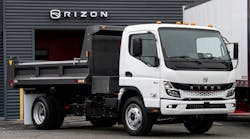After shouldering through the 76,563 attendees crowding the aisles at the 2008 Mid-America Trucking Show in Louisville, KY, one could almost believe better days are here for the trucking industry. However, despite confident outlooks from several manufacturers and suppliers at the show, major challenges still confront the industry, the biggest being skyrocketing diesel fuel prices.
“It's not smooth sailing in the economy right now, with fuel prices at $4 a gallon for diesel and housing starts down,” said Carsten Reinhardt, president of the commercial vehicle systems division at ArvinMeritor. “But there are signs the industry is coming back. We're more bullish than most about that.”
Some of that optimism stems from rising freight volumes. According to tonnage figures compiled by the industry trade group American Trucking Assns., for-hire truck tonnage increased 0.9% in November and 1.5% in December 2007, then jumped 2.4% in January of this year before flattening out in February.
“Business is good but relatively soft compared to what we're used to,” said Dale Corum, general manager of Louisville-based Mercer Transportation. “Just recently, we're starting to see shippers struggling to get trucks. In fact, we're getting emergency fuel surcharges in some cases.”
“Over the last four months, activity has picked up — both in trucking tonnage and in new truck orders,” said Dee Kapur, president of the truck group at International Truck & Engine Corp. Addressing a crowd at the company's booth for the opening of the show, Kapur added: “It might be a good time to start looking at buying new trucks this year. It's time to look at the trucking business again.”
International was one of only two manufacturers showing all-new truck models at Mid-America this year, officially unveiling its LoneStar sleeper and day cab Class 8 tractor (pictured left) designed for owner-operators. Mack Trucks rolled out the other new model:a new heavy-haul Class 8 tractor called the Titan.
While acknowledging the current “tough market” faced by both truck fleets and manufacturers, Paul Vikner, Mack's outgoing president and CEO, stressed during the company's press conference that lessons learned in the transition to EPA '07 engines will make the next emissions hurdle in 2010 less disruptive. That experience, he said, should allow truck manufacturers and their suppliers to avoid the severe prebuy and sales trough it experienced between 2006 and 2007.
Some manufacturers said they are weathering the rough market just fine, thank you very much. “We built 900,000 engines last year for multiple markets worldwide, generating $8.2 billion in revenue. That's more than double our revenue from five years ago; in fact, it's almost triple the revenue,” said Jim Kelly, president of Cummins' global engine business.
“As a company, not only did we perform in 2007 as well as we did in 2004, which at the time was a personal record for us, [but] we had the second best year in our company's history, despite a 50% decline in heavy-duty truck sales and a 43% drop in medium-duty truck sales,” Kelly noted during a press briefing. He chalked up those results to Cummins' ongoing strategy of diversification into other engine markets — power generation, marine, etc. — on a global scale.
“As we shift our focus to 2008 and beyond, we expect to see further growth both in North America and especially from the rest of the world for our products — in spite of the tenuous U.S. economy,” Kelly added. “We expect the truck market to come back somewhere in the second half of this year, and we feel really good about further building market share. We feel our 2007 emissions technology recipe satisfied customers, and they are voting with their wallets in favor of it.”
The high price of fuel is also pushing fleets to take a fresh look at truck specifications, said Ed Saxman, product manager-powertrain for Volvo Trucks North America. “Fuel economy is at the forefront of everyone's mind now,” he said. As a result, fleets are considering a wider range of options simply because of the potential fuel savings.”
In terms of truck sales for 2008, ArvinMeritor projects 220,000 to 240,000 Class 8 trucks will be produced for the U.S., Mexico and Canada. Reinhardt said Class 8 sales totaled just under 50,000 units for the first quarter. He expects sales to reach the mid-50s by the second quarter and climb into the low to mid-60s for the third and fourth quarters.
Reinhardt noted, however, that medium-duty truck sales trends aren't as positive. Total sales for the U.S., Mexico and Canada reached 30,000 units in the first quarter, should grow to 40,000 for the second quarter, and then reach the high 40s for the balance of the year, finishing 2008 with 165,000 medium-duty units sold.
Trailer sales, while strong for now, are most likely going to be lower than ArvinMeritor previously projected, he observed. After sales of 24,000 units in February, sales should taper off and total only 190,000 to 200,000 overall for 2008.
For the U.S. in particular, significant challenges still face trucking, according to Bill Jackson, general manager for Peterbilt Motors Co. At the company's MATS press briefing, Jackson said the trucking business is expected to be volatile in 2008 and 2009, noting that the Federal Reserve recently cut its economic growth forecast by 0.5%, bringing it down to 1.3% to 2% for the balance of this year.
Peterbilt projects Class 8 sales in the U.S. should total 175,000 to 215,000 units for this year, after falling to 176,000 units in 2007 from a record 322,580 units in 2006. Medium-duty Class 5 to 7 sales should total between 80,000 to 95,000 units for the year, Jackson added.
However, Bob Christensen, general manager and Paccar vp at Kenworth Truck Co., stressed that 176,000 in Class 8 sales is a pretty good market by historical standards. “That's not a bad market at all, and we expect to see a new truck sales uptick in the second half of the year,” he said at KW's press conference. “That's because we're finally starting to see an equalization between supply and demand in terms of freight capacity.”
Chris Patterson, president and CEO of Daimler Trucks North America, was more cautious in his outlook though when he addressed a press gathering at the company's multi-brand show display. “Is there light at the end of the tunnel? We hesitate to say freight is on the rebound,” he said, noting that while there was some pickup in tonnage at the end of 2007, freight is still not expected to fully recover this year. He pointed out that ACT Research, for one, is projecting a tonnage decline in 2008.
“Housing, for example, has a significant impact on freight, and housing starts were off 25% in 2007, while new-home sales are at their lowest level in 14 years,” Patterson noted. “That's carried over into 2008, as housing starts were down 28.4% in February, meaning demand for building materials are also heavily affected.”
Despite all of that, ArvinMeritor's Reinhardt remains upbeat. “Sure, if you look at any economic indicator, you could talk yourself into a doom-and-gloom situation, as fuel costs are up and housing is down,” he said. “But we feel the economy is coming back. There's not all that much reason for doom and gloom. In fact, we think the opposite is true now.”


